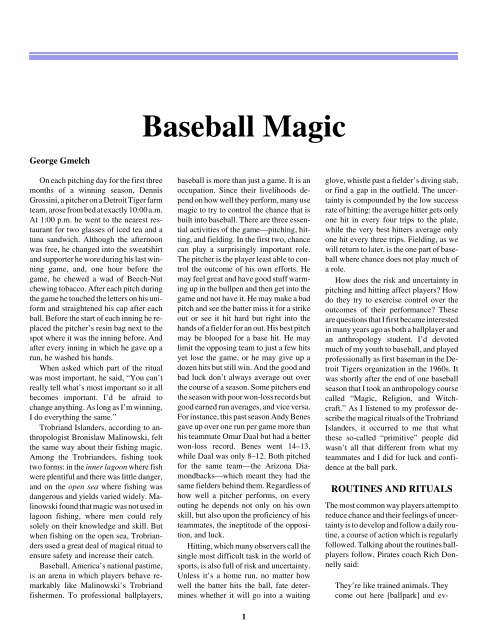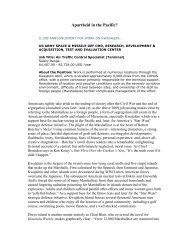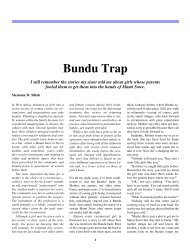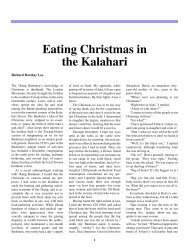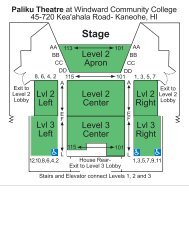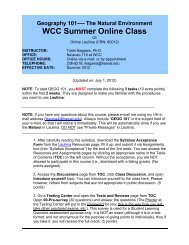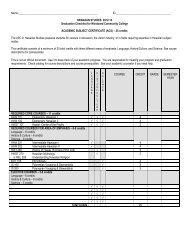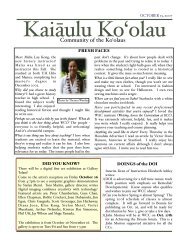Article 32 Baseball Magic - Windward Community College
Article 32 Baseball Magic - Windward Community College
Article 32 Baseball Magic - Windward Community College
Create successful ePaper yourself
Turn your PDF publications into a flip-book with our unique Google optimized e-Paper software.
<strong>Article</strong> <strong>32</strong><br />
George Gmelch<br />
On each pitching day for the first three<br />
months of a winning season, Dennis<br />
Grossini, a pitcher on a Detroit Tiger farm<br />
team, arose from bed at exactly 10:00 a.m.<br />
At 1:00 p.m. he went to the nearest restaurant<br />
for two glasses of iced tea and a<br />
tuna sandwich. Although the afternoon<br />
was free, he changed into the sweatshirt<br />
and supporter he wore during his last winning<br />
game, and, one hour before the<br />
game, he chewed a wad of Beech-Nut<br />
chewing tobacco. After each pitch during<br />
the game he touched the letters on his uniform<br />
and straightened his cap after each<br />
ball. Before the start of each inning he replaced<br />
the pitcher’s resin bag next to the<br />
spot where it was the inning before. And<br />
after every inning in which he gave up a<br />
run, he washed his hands.<br />
When asked which part of the ritual<br />
was most important, he said, “You can’t<br />
really tell what’s most important so it all<br />
becomes important. I’d be afraid to<br />
change anything. As long as I’m winning,<br />
I do everything the same.”<br />
Trobriand Islanders, according to anthropologist<br />
Bronislaw Malinowski, felt<br />
the same way about their fishing magic.<br />
Among the Trobrianders, fishing took<br />
two forms: in the inner lagoon where fish<br />
were plentiful and there was little danger,<br />
and on the open sea where fishing was<br />
dangerous and yields varied widely. Malinowski<br />
found that magic was not used in<br />
lagoon fishing, where men could rely<br />
solely on their knowledge and skill. But<br />
when fishing on the open sea, Trobrianders<br />
used a great deal of magical ritual to<br />
ensure safety and increase their catch.<br />
<strong>Baseball</strong>, America’s national pastime,<br />
is an arena in which players behave remarkably<br />
like Malinowski’s Trobriand<br />
fishermen. To professional ballplayers,<br />
<strong>Baseball</strong> <strong>Magic</strong><br />
baseball is more than just a game. It is an<br />
occupation. Since their livelihoods depend<br />
on how well they perform, many use<br />
magic to try to control the chance that is<br />
built into baseball. There are three essential<br />
activities of the game—pitching, hitting,<br />
and fielding. In the first two, chance<br />
can play a surprisingly important role.<br />
The pitcher is the player least able to control<br />
the outcome of his own efforts. He<br />
may feel great and have good stuff warming<br />
up in the bullpen and then get into the<br />
game and not have it. He may make a bad<br />
pitch and see the batter miss it for a strike<br />
out or see it hit hard but right into the<br />
hands of a fielder for an out. His best pitch<br />
may be blooped for a base hit. He may<br />
limit the opposing team to just a few hits<br />
yet lose the game, or he may give up a<br />
dozen hits but still win. And the good and<br />
bad luck don’t always average out over<br />
the course of a season. Some pitchers end<br />
the season with poor won-loss records but<br />
good earned run averages, and vice versa.<br />
For instance, this past season Andy Benes<br />
gave up over one run per game more than<br />
his teammate Omar Daal but had a better<br />
won-loss record. Benes went 14–13,<br />
while Daal was only 8–12. Both pitched<br />
for the same team—the Arizona Diamondbacks—which<br />
meant they had the<br />
same fielders behind them. Regardless of<br />
how well a pitcher performs, on every<br />
outing he depends not only on his own<br />
skill, but also upon the proficiency of his<br />
teammates, the ineptitude of the opposition,<br />
and luck.<br />
Hitting, which many observers call the<br />
single most difficult task in the world of<br />
sports, is also full of risk and uncertainty.<br />
Unless it’s a home run, no matter how<br />
well the batter hits the ball, fate determines<br />
whether it will go into a waiting<br />
1<br />
glove, whistle past a fielder’s diving stab,<br />
or find a gap in the outfield. The uncertainty<br />
is compounded by the low success<br />
rate of hitting: the average hitter gets only<br />
one hit in every four trips to the plate,<br />
while the very best hitters average only<br />
one hit every three trips. Fielding, as we<br />
will return to later, is the one part of baseball<br />
where chance does not play much of<br />
a role.<br />
How does the risk and uncertainty in<br />
pitching and hitting affect players? How<br />
do they try to exercise control over the<br />
outcomes of their performance? These<br />
are questions that I first became interested<br />
in many years ago as both a ballplayer and<br />
an anthropology student. I’d devoted<br />
much of my youth to baseball, and played<br />
professionally as first baseman in the Detroit<br />
Tigers organization in the 1960s. It<br />
was shortly after the end of one baseball<br />
season that I took an anthropology course<br />
called “<strong>Magic</strong>, Religion, and Witchcraft.”<br />
As I listened to my professor describe<br />
the magical rituals of the Trobriand<br />
Islanders, it occurred to me that what<br />
these so-called “primitive” people did<br />
wasn’t all that different from what my<br />
teammates and I did for luck and confidence<br />
at the ball park.<br />
ROUTINES AND RITUALS<br />
The most common way players attempt to<br />
reduce chance and their feelings of uncertainty<br />
is to develop and follow a daily routine,<br />
a course of action which is regularly<br />
followed. Talking about the routines ballplayers<br />
follow, Pirates coach Rich Donnelly<br />
said:<br />
They’re like trained animals. They<br />
come out here [ballpark] and ev-
ANNUAL EDITIONS<br />
erything has to be the same, they<br />
don’t like anything that knocks<br />
them off their routine. Just look at<br />
the dugout and you’ll see every<br />
guy sitting in the same spot every<br />
night. It’s amazing, everybody in<br />
the same spot. And don’t you dare<br />
take someone’s seat. If a guy<br />
comes up from the minors and sits<br />
here, they’ll say, ‘Hey, Jim sits<br />
here, find another seat.’ You watch<br />
the pitcher warm up and he’ll do<br />
the same thing every time. And<br />
when you go on the road it’s the<br />
same way. You’ve got a routine<br />
and you adhere to it and you don’t<br />
want anybody knocking you off it.<br />
Routines are comforting, they bring<br />
order into a world in which players have<br />
little control. And sometimes practical elements<br />
in routines produce tangible benefits,<br />
such as helping the player<br />
concentrate. But what players often do<br />
goes beyond mere routine. Their actions<br />
become what anthropologists define as<br />
ritual—prescribed behaviors in which<br />
there is no empirical connection between<br />
the means (e.g., tapping home plate three<br />
times) and the desired end (e.g., getting a<br />
base hit). Because there is no real connection<br />
between the two, rituals are not rational,<br />
and sometimes they are actually<br />
irrational. Similar to rituals are the nonrational<br />
beliefs that form the basis of taboos<br />
and fetishes, which players also use<br />
to reduce chance and bring luck to their<br />
side. But first let’s look more closely at<br />
rituals.<br />
Most rituals are personal, that is,<br />
they’re performed by individuals rather<br />
than by a team or group. Most are done in<br />
an unemotional manner, in much the<br />
same way players apply pine tar to their<br />
bats to improve the grip or dab eye black<br />
on their upper cheeks to reduce the sun’s<br />
glare. <strong>Baseball</strong> rituals are infinitely varied.<br />
A ballplayer may ritualize any activity—eating,<br />
dressing, driving to the<br />
ballpark—that he considers important or<br />
somehow linked to good performance.<br />
For example, Yankee pitcher Denny Neagle<br />
goes to a movie on days he is scheduled<br />
to start. Pitcher Jason Bere listens to<br />
the same song on his Walkman on the<br />
days he is to pitch. Jim Ohms puts another<br />
penny in the pouch of his supporter after<br />
each win. Clanging against the hard plastic<br />
genital cup, the pennies made a noise<br />
as he ran the bases toward the end of a<br />
winning season. Glenn Davis would chew<br />
the same gum every day during hitting<br />
streaks, saving it under his cap. Infielder<br />
Julio Gotay always played with a cheese<br />
sandwich in his back pocket (he had a big<br />
appetite, so there might also have been a<br />
measure of practicality here). Wade<br />
Boggs ate chicken before every game during<br />
his career, and that was just one of<br />
dozens of elements in his pre and post<br />
game routine, which also included leaving<br />
his house for the ballpark at precisely<br />
the same time each day (1:47 for a 7:05<br />
game). Former Oriole pitcher Dennis<br />
Martinez would drink a small cup of water<br />
after each inning and then place it under<br />
the bench upside down, in a line. His<br />
teammates could always tell what inning<br />
it was by counting the cups.<br />
Many hitters go through a series of preparatory<br />
rituals before stepping into the<br />
batter’s box. These include tugging on<br />
their caps, touching their uniform letters<br />
or medallions, crossing themselves, tapping<br />
or bouncing the bat on the plate, or<br />
swinging the weighted warm-up bat a prescribed<br />
number of times. Consider Red<br />
Sox Nomar Garciaparra. After each pitch<br />
he steps out of the batters box, kicks the<br />
dirt with each toe, adjusts his right batting<br />
glove, adjusts his left batting glove, and<br />
touches his helmet before getting back<br />
into the box. Mike Hargrove, former<br />
Cleveland Indian first baseman, had so<br />
many time consuming elements in his batting<br />
ritual that he was known as “the human<br />
rain delay.” Both players believe<br />
their batting rituals helped them regain<br />
their concentration after each pitch. But<br />
others wonder if they have become prisoners<br />
of their own superstitions. Also,<br />
players who have too many or particularly<br />
bizarre rituals risk being labeled as<br />
“flakes,” and not just by teammates but by<br />
fans and media as well. For example,<br />
pitcher Turk Wendell’s eccentric rituals,<br />
which included wearing a necklace of<br />
teeth from animals he had killed, made<br />
him a cover story in the New York Times<br />
Sunday Magazine.<br />
Some players, especially Latin Americans,<br />
draw upon rituals from their Roman<br />
Catholic religion. Some make the<br />
sign of the cross or bless themselves be-<br />
2<br />
fore every at bat, and a few like the Rangers’<br />
Pudge Rodriguez do so before every<br />
pitch. Others, like the Detroit Tiger Juan<br />
Gonzalez, also visibly wear religious medallions<br />
around their necks, while some<br />
tuck them discretely inside their undershirts.<br />
One ritual associated with hitting is<br />
tagging a base when leaving and returning<br />
to the dugout between innings. Some<br />
players don’t “feel right” unless they tag<br />
a specific base on each trip between the<br />
dugout and the field. One of my teammates<br />
added some complexity to his ritual<br />
by tagging third base on his way to the<br />
dugout only after the third, sixth, and<br />
ninth innings. Asked if he ever purposely<br />
failed to step on the bag, he replied,<br />
“Never! I wouldn’t dare. It would destroy<br />
my confidence to hit.” <strong>Baseball</strong> fans observe<br />
a lot of this ritual behavior, such as<br />
fielders tagging bases, pitchers tugging<br />
on their caps or touching the resin bag after<br />
each bad pitch, or smoothing the dirt<br />
on the mound before each new batter or<br />
inning, never realizing the importance of<br />
these actions to the player. The one ritual<br />
many fans do recognize, largely because<br />
it’s a favorite of TV cameramen, is the<br />
“rally cap”—players in the dugout folding<br />
their caps and wearing them bill up in<br />
hopes of sparking a rally.<br />
Most rituals grow out of exceptionally<br />
good performances. When a player does<br />
well, he seldom attributes his success to<br />
skill alone. He knows that his skills were<br />
essentially the same the night before. He<br />
asks himself, “What was different about<br />
today which explains my three hits?” He<br />
decides to repeat what he did today in an<br />
attempt to bring more good luck. And so<br />
he attributes his success, in part, to an object,<br />
a food he ate, not having shaved, a<br />
new shirt he bought that day, or just about<br />
any behavior out of the ordinary. By repeating<br />
that behavior, he seeks to gain<br />
control over his performance. Outfielder<br />
John White explained how one of his rituals<br />
started:<br />
I was jogging out to centerfield after<br />
the national anthem when I<br />
picked up a scrap of paper. I got<br />
some good hits that night and I<br />
guess I decided that the paper had<br />
something to do with it. The next<br />
night I picked up a gum wrapper
and had another good night at the<br />
plate… I’ve been picking up paper<br />
every night since.<br />
Outfielder Ron Wright of the Calgary<br />
Cannons shaves his arms once a week and<br />
plans to continue doing so until he has a<br />
bad year. It all began two years before<br />
when after an injury he shaved his arm so<br />
it could be taped, and proceeded to hit<br />
three homers over the next few games.<br />
Now he not only has one of the smoothest<br />
swings in the minor leagues, but two of<br />
the smoothest forearms. Wade Boggs’<br />
routine of eating chicken before every<br />
game began when he was a rookie in<br />
1982. He noticed a correlation between<br />
multiple hit games and poultry plates (his<br />
wife has over 40 chicken recipes). One of<br />
Montreal Expos farmhand Mike Saccocio’s<br />
rituals also concerned food, “I got<br />
three hits one night after eating at Long<br />
John Silver’s. After that when we’d pull<br />
into town, my first question would be,<br />
“Do you have a Long John Silver’s?” Unlike<br />
Boggs, Saccocio abandoned his ritual<br />
and looked for a new one when he stopped<br />
hitting well.<br />
When in a slump, most players make a<br />
deliberate effort to change their rituals<br />
and routines in an attempt to shake off<br />
their bad luck. One player tried taking different<br />
routes to the ballpark; several players<br />
reported trying different combinations<br />
of tagging and not tagging particular<br />
bases in an attempt to find a successful<br />
combination. I had one manager who<br />
would rattle the bat bin when the team was<br />
not hitting well, as if the bats were in a stupor<br />
and could be aroused by a good shaking.<br />
Similarly, I have seen hitters rub their<br />
hands along the handles of the bats protruding<br />
from the bin in hopes of picking<br />
up some power or luck from bats that are<br />
getting hits for their owners. Some players<br />
switch from wearing their contact<br />
lenses to glasses. Brett Mandel described<br />
his Pioneer League team, the Ogden Raptors,<br />
trying to break a losing streak by using<br />
a new formation for their pre-game<br />
stretching. 1<br />
TABOO<br />
Taboos are the opposite of rituals. The<br />
word taboo comes from a Polynesian term<br />
meaning prohibition. Breaking a taboo,<br />
players believe, leads to undesirable consequences<br />
or bad luck. Most players observe<br />
at least a few taboos, such as never<br />
stepping on the white foul lines. A few,<br />
like the Mets Turk Wendell and Red Sox<br />
Nomar Garciaparra, leap over the entire<br />
basepath. One teammate of mine would<br />
never watch a movie on a game day, despite<br />
the fact that we played nearly every<br />
day from April to September. Another<br />
teammate refused to read anything before<br />
a game because he believed it weakened<br />
his batting eye.<br />
Many taboos take place off the field,<br />
out of public view. On the day a pitcher is<br />
scheduled to start, he is likely to avoid activities<br />
he believes will sap his strength<br />
and detract from his effectiveness. Some<br />
pitchers avoid eating certain foods, others<br />
will not shave on the day of a game, refusing<br />
to shave again as long as they are<br />
winning. Early in the 1989 season Oakland’s<br />
Dave Stewart had six consecutive<br />
victories and a beard by the time he lost.<br />
Taboos usually grow out of exceptionally<br />
poor performances, which players, in<br />
search of a reason, attribute to a particular<br />
behavior. During my first season of pro<br />
ball I ate pancakes before a game in which<br />
I struck out three times. A few weeks later<br />
I had another terrible game, again after<br />
eating pancakes. The result was a pancake<br />
taboo: I never again ate pancakes during<br />
the season. Pitcher Jason Bere has a taboo<br />
that makes more sense in dietary terms:<br />
after eating a meatball sandwich and not<br />
pitching well, he swore off them for the<br />
rest of the season.<br />
While most taboos are idiosyncratic,<br />
there are a few that all ball players hold<br />
and that do not develop out of individual<br />
experience or misfortune. These form<br />
part of the culture of baseball, and are<br />
sometimes learned as early as Little<br />
League. Mentioning a no-hitter while one<br />
is in progress is a well-known example. It<br />
is believed that if a pitcher hears the words<br />
“no-hitter,” the spell accounting for this<br />
hard to achieve feat will be broken and the<br />
no-hitter lost. This taboo is also observed<br />
by many sports broadcasters, who use<br />
various linguistic subterfuges to inform<br />
their listeners that the pitcher has not<br />
given up a hit, never saying “no-hitter.”<br />
3<br />
<strong>Article</strong> <strong>32</strong>. <strong>Baseball</strong> <strong>Magic</strong><br />
FETISHES<br />
Fetishes or charms are material objects<br />
believed to embody “supernatural”<br />
power that can aid or protect the owner.<br />
Good luck charms are standard equipment<br />
for some ballplayers. These include<br />
a wide assortment of objects from coins,<br />
chains, and crucifixes to a favorite baseball<br />
hat. The fetishized object may be a<br />
new possession or something a player<br />
found that happens to coincide with the<br />
start of a streak and which he holds responsible<br />
for his good fortune. While<br />
playing in the Pacific Coast League, Alan<br />
Foster forgot his baseball shoes on a road<br />
trip and borrowed a pair from a teammate.<br />
That night he pitched a no-hitter, which he<br />
attributed to the shoes. Afterwards he<br />
bought them from his teammate and they<br />
became a fetish. Expo farmhand Mark<br />
LaRosa’s rock has a different origin and<br />
use:<br />
I found it on the field in Elmira after<br />
I had gotten bombed. It’s unusual,<br />
perfectly round, and it<br />
caught my attention. I keep it to remind<br />
me of how important it is to<br />
concentrate. When I am going well<br />
I look at the rock and remember to<br />
keep my focus, the rock reminds<br />
me of what can happen when I lose<br />
my concentration.<br />
For one season Marge Schott, former<br />
owner of the Cincinnati Reds, insisted<br />
that her field manager rub her St. Bernard<br />
“Schotzie” for good luck before each<br />
game. When the Reds were on the road,<br />
Schott would sometimes send a bag of the<br />
dog’s hair to the field manager’s hotel<br />
room.<br />
During World War II, American soldiers<br />
used fetishes in much the same way.<br />
Social psychologist Samuel Stouffer and<br />
his colleagues found that in the face of<br />
great danger and uncertainty, soldiers developed<br />
magical practices, particularly<br />
the use of protective amulets and good<br />
luck charms (crosses, Bibles, rabbits’<br />
feet, medals), and jealously guarded articles<br />
of clothing they associated with past<br />
experiences of escape from danger. 2<br />
Stouffer also found that prebattle preparations<br />
were carried out in fixed ritual-
ANNUAL EDITIONS<br />
like order, similar to ballplayers preparing<br />
for a game.<br />
Uniform numbers have special significance<br />
for some players who request their<br />
lucky number. Since the choice is usually<br />
limited, they try to at least get a uniform<br />
that contains their lucky number, such as<br />
14, 24, 34, or 44 for the player whose<br />
lucky number is four. When Ricky Henderson<br />
came to the Blue Jays in 1993 he<br />
paid outfielder Turner Ward $25,000 for<br />
the right to wear number 24. Oddly<br />
enough, there is no consensus about the<br />
effect of wearing number 13. Some players<br />
will not wear it, others will, and a few<br />
request it. Number preferences emerge in<br />
different ways. A young player may request<br />
the number of a former star, hoping<br />
that—through what anthropologists call<br />
imitative magic—it will bring him the<br />
same success. Or he may request a number<br />
he associates with good luck. While<br />
with the Oakland A’s Vida Blue changed<br />
his uniform number from 35 to 14, the<br />
number he wore as a high-school quarterback.<br />
When 14 did not produce better<br />
pitching performance, he switched back<br />
to 35. Former San Diego Padre first baseman<br />
Jack Clark changed his number from<br />
25 to 00, hoping to break out of a slump.<br />
That day he got four hits in a double<br />
header, but also hurt his back. Then, three<br />
days later, he was hit in the cheekbone by<br />
a ball thrown in batting practice.<br />
Colorado Rockies Larry Walker’s fixation<br />
with the number three has become<br />
well known to baseball fans. Besides<br />
wearing 33, he takes three practice swings<br />
before stepping into the box, he showers<br />
from the third nozzle, sets his alarm for<br />
three minutes past the hour and he was<br />
wed on November 3 at 3:33 p.m. Fans in<br />
ballparks all across America rise from<br />
their seats for the seventh inning stretch<br />
before the home club comes to bat because<br />
the number seven is lucky, although<br />
the origin of this tradition has been lost.<br />
Clothing, both the choice and the order<br />
in which they are put on, combine elements<br />
of both ritual and fetish. Some<br />
players put on their uniform in a ritualized<br />
order. Expos farmhand Jim Austin always<br />
puts on his left sleeve, left pants leg, and<br />
left shoe before the right. Most players,<br />
however, single out one or two lucky articles<br />
or quirks of dress for ritual elaboration.<br />
After hitting two home runs in a<br />
game, for example, ex-Giant infielder Jim<br />
Davenport discovered that he had missed<br />
a buttonhole while dressing for the game.<br />
For the remainder of his career he left the<br />
same button undone. For outfielder Brian<br />
Hunter the focus is shoes, “I have a pair of<br />
high tops and a pair of low tops. Whichever<br />
shoes don’t get a hit that game, I<br />
switch to the other pair.” At the time of our<br />
interview, he was struggling at the plate<br />
and switching shoes almost every day.<br />
For Birmingham Baron pitcher Bo<br />
Kennedy the arrangement of the different<br />
pairs of baseball shoes in his locker is critical:<br />
I tell the clubies [clubhouse boys]<br />
when you hang stuff in my locker<br />
don’t touch my shoes. If you bump<br />
them move them back. I want the<br />
Pony’s in front, the turfs to the<br />
right, and I want them nice and<br />
neat with each pair touching each<br />
other…. Everyone on the team<br />
knows not to mess with my shoes<br />
when I pitch.<br />
During streaks—hitting or winning—<br />
players may wear the same clothes day after<br />
day. Once I changed sweatshirts midway<br />
through the game for seven<br />
consecutive nights to keep a hitting streak<br />
going. Clothing rituals, however, can become<br />
impractical. Catcher Matt Allen<br />
was wearing a long sleeve turtle neck shirt<br />
on a cool evening in the New York-Penn<br />
League when he had a three-hit game. “I<br />
kept wearing the shirt and had a good<br />
week,” he explained. “Then the weather<br />
got hot as hell, 85 degrees and muggy, but<br />
I would not take that shirt off. I wore it for<br />
another ten days—catching—and people<br />
thought I was crazy.” Also taking a ritual<br />
to the extreme, Leo Durocher, managing<br />
the Brooklyn Dodgers to a pennant in<br />
1941, is said to have spent three and a half<br />
weeks in the same gray slacks, blue coat,<br />
and knitted blue tie. During a 16-game<br />
winning streak, the 1954 New York Giants<br />
wore the same clothes in each game<br />
and refused to let them be cleaned for fear<br />
that their good fortune might be washed<br />
away with the dirt. Losing often produces<br />
the opposite effect. Several Oakland A’s<br />
players, for example, went out and bought<br />
new street clothes in an attempt to break a<br />
fourteen-game losing streak.<br />
4<br />
<strong>Baseball</strong>’s superstitions, like most everything<br />
else, change over time. Many of<br />
the rituals and beliefs of early baseball are<br />
no longer observed. In the 1920s and<br />
1930s sportswriters reported that a player<br />
who tripped en route to the field would often<br />
retrace his steps and carefully walk<br />
over the stumbling block for “insurance.”<br />
A century ago players spent time on and<br />
off the field intently looking for items that<br />
would bring them luck. To find a hairpin<br />
on the street, for example, assured a batter<br />
of hitting safely in that day’s game. Today<br />
few women wear hairpins—a good reason<br />
the belief has died out. To catch sight<br />
of a white horse or a wagon-load of barrels<br />
were also good omens. In 1904 the<br />
manager of the New York Giants, John<br />
McGraw, hired a driver with a team of<br />
white horses to drive past the Polo<br />
Grounds around the time his players were<br />
arriving at the ballpark. He knew that if<br />
his players saw white horses, they’d have<br />
more confidence and that could only help<br />
them during the game. Belief in the power<br />
of white horses survived in a few backwaters<br />
until the 1960s. A gray haired<br />
manager of a team I played for in Drummondville,<br />
Quebec, would drive around<br />
the countryside before important games<br />
and during the playoffs looking for a<br />
white horse. When he was successful, he<br />
would announce it to everyone in the<br />
clubhouse.<br />
One belief that appears to have died<br />
out recently is a taboo about crossed bats.<br />
Some of my Latino teammates in the<br />
1960s took it seriously. I can still recall<br />
one Dominican player becoming agitated<br />
when another player tossed a bat from the<br />
batting cage and it landed on top of his bat.<br />
He believed that the top bat might steal<br />
hits from the lower one. In his view, bats<br />
contained a finite number of hits, a sort of<br />
baseball “image of limited good.” It was<br />
once commonly believed that when the<br />
hits in a bat were used up no amount of<br />
good hitting would produce any more.<br />
Hall of Famer Honus Wagner believed<br />
each bat contained only 100 hits. Regardless<br />
of the quality of the bat, he would discard<br />
it after its 100th hit. This belief would<br />
have little relevance today, in the era of<br />
light bats with thin handles—so thin that<br />
the typical modern bat is lucky to survive<br />
a dozen hits without being broken. Other<br />
superstitions about bats do survive, how-
ever. Position players on the Class A<br />
Asheville Tourists, for example, would<br />
not let pitchers touch or swing their bats,<br />
not even to warm up. Poor-hitting players,<br />
as most pitchers are, were said to pollute<br />
or weaken the bats.<br />
UNCERTAINTY AND<br />
MAGIC<br />
The best evidence that players turn to rituals,<br />
taboos, and fetishes to control<br />
chance and uncertainty is found in their<br />
uneven application. They are associated<br />
mainly with pitching and hitting—the activities<br />
with the highest degree of<br />
chance—and not fielding. I met only one<br />
player who had any ritual in connection<br />
with fielding, and he was an error prone<br />
shortstop. Unlike hitting and pitching, a<br />
fielder has almost complete control over<br />
the outcome of his performance. Once a<br />
ball has been hit in his direction, no one<br />
can intervene and ruin his chances of<br />
catching it for an out (except in the unlikely<br />
event of two fielders colliding).<br />
Compared with the pitcher or the hitter,<br />
the fielder has little to worry about. He<br />
knows that, in better than 9.7 times out of<br />
10, he will execute his task flawlessly.<br />
With odds like that there is little need for<br />
ritual.<br />
Clearly, the rituals of American ballplayers<br />
are not unlike that of the Trobriand<br />
Islanders studied by Malinowski<br />
many years ago. 3 In professional baseball,<br />
fielding is the equivalent of the inner<br />
lagoon while hitting and pitching are like<br />
the open sea.<br />
While Malinowski helps us understand<br />
how ballplayers respond to chance<br />
and uncertainty, behavioral psychologist<br />
B. F. Skinner sheds light on why personal<br />
rituals get established in the first place. 4<br />
With a few grains of seed Skinner could<br />
get pigeons to do anything he wanted. He<br />
merely waited for the desired behavior<br />
(e.g. pecking) and then rewarded it with<br />
some food. Skinner then decided to see<br />
what would happen if pigeons were rewarded<br />
with food pellets regularly, every<br />
fifteen seconds, regardless of what they<br />
did. He found that the birds associate the<br />
arrival of the food with a particular action,<br />
such as tucking their head under a wing or<br />
walking in clockwise circles. About ten<br />
seconds after the arrival of the last pellet,<br />
a bird would begin doing whatever it associated<br />
with getting the food and keep<br />
doing it until the next pellet arrived. In<br />
short, the pigeons behaved as if their actions<br />
made the food appear. They learned<br />
to associate particular behaviors with the<br />
reward of being given seed.<br />
Ballplayers also associate a reward—<br />
successful performance—with prior behavior.<br />
If a player touches his crucifix and<br />
then gets a hit, he may decide the gesture<br />
was responsible for his good fortune and<br />
touch his crucifix the next time he comes<br />
to the plate. If he gets another hit, the<br />
chances are good that he will touch his<br />
crucifix each time he bats. Unlike pigeons,<br />
however, most ballplayers are<br />
quicker to change their rituals once they<br />
no longer seem to work. Skinner found<br />
that once a pigeon associated one of its actions<br />
with the arrival of food or water,<br />
only sporadic rewards were necessary to<br />
keep the ritual going. One pigeon, believing<br />
that hopping from side to side brought<br />
pellets into its feeding cup, hopped ten<br />
thousand times without a pellet before finally<br />
giving up. But, then, didn’t Wade<br />
Boggs eat chicken before every game,<br />
5<br />
<strong>Article</strong> <strong>32</strong>. <strong>Baseball</strong> <strong>Magic</strong><br />
through slumps and good times, for seventeen<br />
years?<br />
Obviously the rituals and superstitions<br />
of baseball do not make a pitch travel<br />
faster or a batted ball find the gaps between<br />
the fielders, nor do the Trobriand<br />
rituals calm the seas or bring fish. What<br />
both do, however, is give their practitioners<br />
a sense of control, with that added<br />
confidence, at no cost. And we all know<br />
how important that is. If you really believe<br />
eating chicken or hopping over the<br />
foul lines will make you a better hitter, it<br />
probably will.<br />
BIBLIOGRAPHY<br />
Malinowski, B. <strong>Magic</strong>, Science and Religion<br />
and Other Essays (Glencoe, III., 1948).<br />
Mandel, Brett. Minor Players, Major Dreams.<br />
Lincoln, Nebraska: University of Nebraska<br />
Press, 1997.<br />
Skinner, B.F. Behavior of Organisms: An<br />
Experimental Analysis (D. Appleton-<br />
Century Co., 1938).<br />
Skinner, B.F. Science and Human Behavior<br />
(New York: Macmillan, 1953).<br />
Stouffer, Samuel. The American Soldier.<br />
New York: J. Wiley, 1965.<br />
Torrez, Danielle Gagnon. High Inside: Memoirs<br />
of a <strong>Baseball</strong> Wife. New York: G.P.<br />
Putnam’s Sons, 1983.<br />
NOTES<br />
1. Mandel, Minor Players, Major Dreams,<br />
156.<br />
2. Stouffer, The American Soldier<br />
3. Malinowski, B. <strong>Magic</strong>, Science and Religion<br />
and Other Essays<br />
4. Skinner, B.F. Behavior of Organisms:<br />
An Experimental Analysis<br />
Department of Anthropology, Union <strong>College</strong>;<br />
e-mail gmelchg@union.edu<br />
Revised version of "Superstition and Ritual in American <strong>Baseball</strong>" from Elysian Fields Quarterly, Vol. 11, No. 3, 1992, pp. 25-36. © September 2000,<br />
McGraw-Hill/Dushkin, with permission of the author, George Gmelch.


